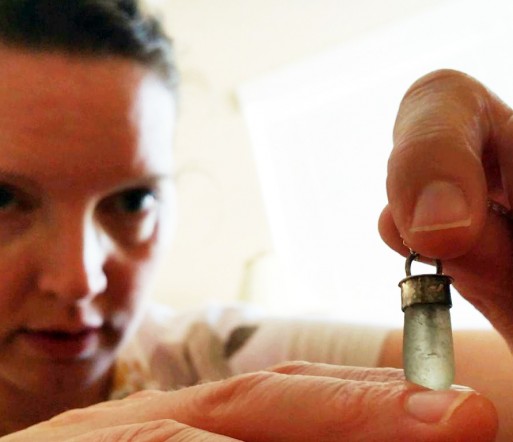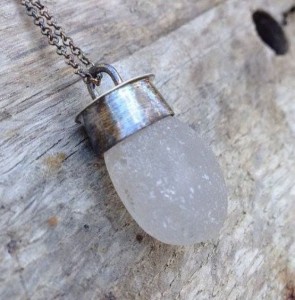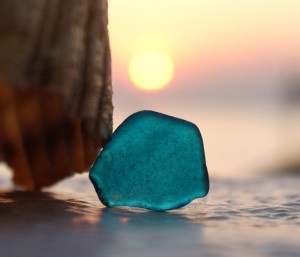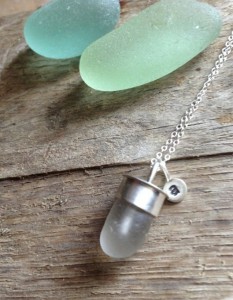
Straka holds one of her pieces: a faint trace of the spot for ashes can be seen in the light.
(Credit: Amanda Straka)
Moving through the process of mourning the death of someone you love is a complicated path. Through time, the sharp intensity of loss softens a bit. The deeply transformative throes of grief ebb and flow as we come to terms with loss.
It can be helpful to have objects around us that remind us of those we love and have lost. Objects hold embedded memories, as photographs or clothing do. Traces of our loved one’s physical existence can be comforting, and often people choose to keep their loved one’s cremated remains in an urn or other adorned object in the house.
With Amanda’s Straka’s memorial jewelry, you can keep some of your loved one’s remains close to your physical heart.
Using sterling silver and sea glass, Straka creates bespoke necklaces that reflect the beauty and mystery of loss.
With Amanda’s Straka’s memorial jewelry, you can keep some of your loved one’s cremains close to your physical heart.
Straka carefully drills into the sea glass to create a home for a small amount of collected ashes. The sea glass vessel is then sealed and topped with a simple but striking sterling silver cap.
The space created for the ashes is a visual whisper, leaving it up to the wearer to publicize the piece’s meaning and purpose, or to keep it private and to themselves. Her pieces stand on their own as beautiful objects; the cloudy glass and clean lines of the silver caps have a straightforward, contemporary feel.
Sea glass is a product of transformation. Sharp shards of tossed away glass get smoothed over as the sure forces of time and water have their way.
History is embedded in the glass. Different colors speak to industrial materials available in different places and eras. Collectors prize certain rare colors, which become jewel-like, dotting coasts around the world.
The embedded history and surface transformation of sea glass is what attracted Straka to the material. As she experienced grief at the death of a loved one, Straka searched for meaningful memorial jewelry and couldn’t find what her heart was seeking. So she set out to make it, and shares the skills she honed with other people.
We live in a place and era that has few public prescriptions for what mourning is supposed to look like. In Victorian England, rigid social norms determined the dress and jewelry for publicly described stages of mourning, and women, as symbols of a family, were held to the expectations of dress. Adhering to these norms established and maintained a family’s social status.
How lucky we are to have some say in how we want to move through and with grief. In the age of the individual, social status certainly isn’t as dependent on adherence to aestheticized norms — the shifting sands of psychology may provide some structure, but highly prescribed social norms hold little sway in the public process of grieving. Thus, deeply personal objects, such as Straka’s memorial pendants, can exist in the public sphere as powerful but quiet pieces of art, held close to the heart and dripping with poignant, personal meaning.
You can see more of Straka’s work at her Etsy shop, Blue Whale Trading.

 Remains Close to the Heart
Remains Close to the Heart





 “Hand to Earth” by Andy Goldsworthy
“Hand to Earth” by Andy Goldsworthy
 Trans Remembrance Project Provides a Community of Grieving
Trans Remembrance Project Provides a Community of Grieving
 Caring for a Dying Loved One? Be Gentle With Yourself.
Caring for a Dying Loved One? Be Gentle With Yourself.














